|
The Street
Wickhambreaux
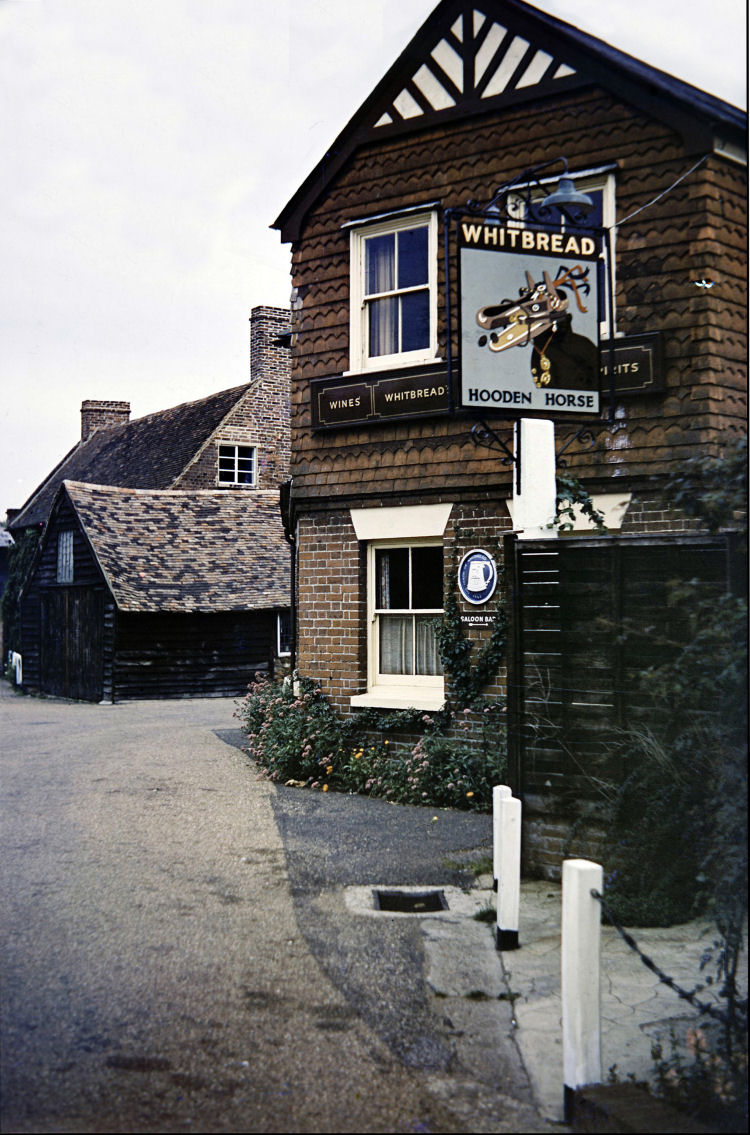
Above photo kindly sent by Andrew Campbell who says this picture was
taken by Colin Bennett.
|
|
From the leaflet issued on the opening of the Hooden Horse, 21 July 1957.
PROGRAMME. 21st July, 1956.
7.00 p.m.
Arrival of Morris Men & Hooden Horse.
(East kent Morris men)
(Ravensbourne Morris men.)
7.25. p.m.
Traditional Airs on Handbells.
(Folkestone National Folk Dance Group.)
7.30 p.m.
Unveiling Ceremony by Sir Stephen Tallents. K.G.M.G., C.B., C.B.E.
7.45 p.m.
Community Dancing.
(English Folk Dance and Song Society.)
By ANNE ROPER. M.B.E., J.P., F.S.A.
The "HOODEN HORSE" is one of the oldest, the moot interesting and
most remarkable survivals of the pagan past in Kent. Although its origin
seems lost in antiquity, the custom is one associated with our
Scandinavian ancestors and their worship of Odin the Saxon form is "Woden"
- the chief god of northern mythology.
Woden was the ruler of heaven and earth, and in far-off winters, rode
fast through the night sky over the cold plains of Northern Europe, on
his famous horse, Sleipner, which was eight footed.
At the annual festival of Jul. which celebrated the returning light
and warmth of the sun, at the winter solstice, the old Teutonic tribes
sacrificed their horses as offerings to Odin, and round their fires they
consumed the animals' flesh.
After the Roman occupation of Britain, hordes of Jutes, under Hengist
and Horsa invaded the shores of Thanet in 449 A.D, and overran that
corner of Kent. They were worshippers of Woden and the traditions of the
pagan customs survive to the present day. To them we owe the Kentish
name Woodnesborough, and our midweek day. Wednesday.
In successive centuries, with the gradual spread of Christianity,
animal sacrifices and the eating of horse flesh were condemned,
specifically by Archbishop Theodore, but it is to these pagan practices
that we trace the Hooden Horse that has persisted even until today, in
the place where in England it probably began, this corner of East Kent.
On Christmas Eve, it was the custom, in almost every village and
hamlet in the Isle of Thanet, and a great deal of the district around,
to go "a-hoodening". The party consisted usually of farm hands, those
who were engaged with horses, waggoners and their mates, and originally
the farmer would send his best horse, but as time went on, a full-sired
horse’s head, fashioned of wood, was substituted. The Hoodeners were
fantastically dressed, and among them was often one dressed in female
clothes, who earned a birch broom, and was called "The Old Woman" or
just "Mollie". Details of the horse’s head differed in various
neighbourhoods. Occasionally large holes were hollowed out for eyes, and
black glass bottoms of bottles were inserted. In Thanet, great hobnails
were driven into the jaws to form teeth, the lower jaw was hung on
hinges, and made to open or shut by means of a string, and it could be
made to snap quite ferociously. This head was fixed to a pole about four
feet in length, and earned by the stoutest "hand", who was called the
Horse. He walked with a stooping gait to make as good a "back” as
possible and was covered with a large horse cloth or sacking. Reins,
ribbons and a bridle were attached to the head and at times one of the
smaller "hands" mounted the Horse to ride like a jockey. The men carried
sheep-bells or handbells, and perhaps one was able to play the fiddle.
The assembled party set out and visited the various farms and houses,
making plenty of noise to announce their arrival. accompanied by the
"clap clapping" of the Horse's jaws. As soon as the door was flung open,
the Waggoner cracked his whip, and led in the Horse prancing, snorting,
gnashing his teeth, kicking, and rearing very spiritedly, while Mollie
began energetically to sweep the feet of the first person to appear.
When the fun and laughter had subsided, the Hoodeners rang their
handbells, and sang some carols, and were regaled with some brewed ale,
cider and cakes, or on more fortunate occasions with contributions of
money.
But countrymen in their enthusiasm do not always deal kindly with
ancient customs. "Hob Nob" at Salisbury had to be locked in the City
Museum. At Broadstairs after a woman was alleged to have been frightened
to death in meeting a party of Hoodeners, the Magistrates suppressed the
custom in that town, but it continued further down the coast as far as
Deal, and as far inland as Canterbury. One Hooden Horse at Lower Hardres
in 1859 caused a crippled woman to jump from her chair and run. This
Horse was so respected by her German husband that he bought it and took
it with him to Germany.
With the coming of the petrol engine, there are fewer horses, fewer
waggoners; stables, alas, have become tractor sheds, and the old Hooden
Horse has been taken down from the walls and burned in the stackyard.
Yet the tradition remained, and the Hooden Horse, modelled on the one
formerly at Deal, re-appeared at Folkestone at the Coronation
festivities of Queen Elizabeth II, resurrected appropriately by the
Folkestone National Folk Dance Group. Each successive Christmas, while
cold winds streak across Kent from Scandinavia, the party may be seen,
with their handbells, and the gallant Horse prancing as grotesquely as
ever, making the rounds to give pleasure and to collect and swallow
money, now, for some thoroughly deserving cause.
At Whitsuntide the Hoodeners set out from Charing, with the Horse and
the East Kent Morris Men, bringing tidings of Spring fertility to the
countryside and coast.
In this modern mechanical age, there is still room for these curious
old customs, and how immeasurably poorer we should be without them. They
arc not simply cherished fancies of the "good old days", but precious
links with the past to be safeguarded and handed down for future
generations. The Hooden Horse is now depicted on the sign of an inn at
Wickhambreaux, and as long as it hangs there, in the heart of the Hooden
Horse country, this popular Kentish custom, though pagan in origin, will
be perpetuated in the minds and memory of all who pass that way.
Anne Roper.
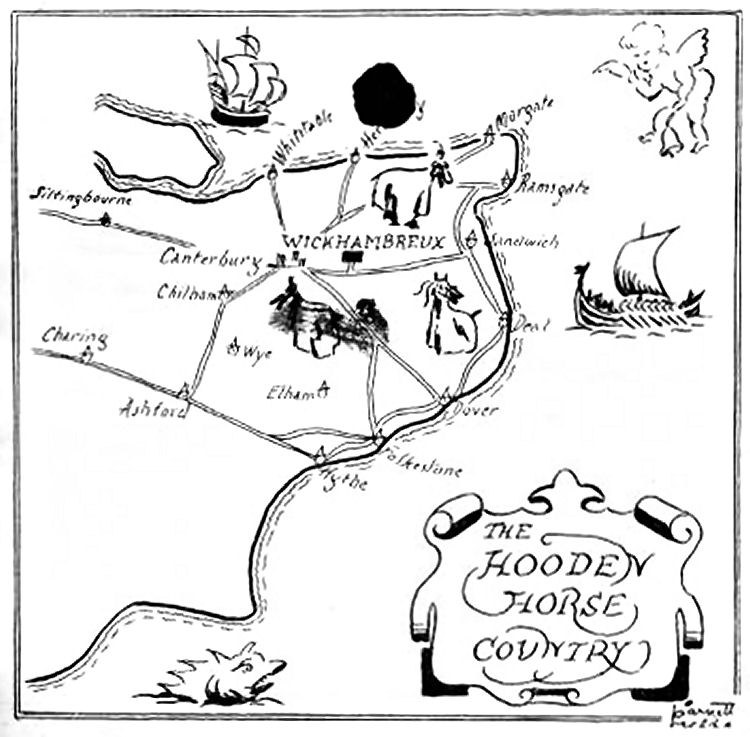 |
|
From the Kent Messenger, 27 July 1956.
The Hooden Horse comes 'prancing' in.
AND THE WHITE SWAN EXITS AT WICKHAMBREAUX.
A FEARSOME clacking horse has ousted the "Swan" from its quiet abode in
the charming old picture postcard village of Wickhambreaux, near
Canterbury.
The arrival of the horse — a hooden horse — was feted in the village on
Saturday evening with traditional old English ceremony.
Beneath the elms and chestnuts Morris men, ribbons crossed on their
white clothes and tiny silver bells jangling from their legs as they
danced, performed the quaint dances of a bygone rural England.
Although everyone celebrated the return or the hooden horse there was no
one to mourn the passing of the white swan that had for many years gazed
down from a hanging inn sign.
“I HATE SWANS"
Even Sir Stephen Tallents, who unveiled the new sign, had not a good
word to say for the bird. "I hate swans," he said.
The reason for this prejudice, he explained, was that one day he was
clearing out a moat when a swan "went for him." In trying to beat it off
ho fell backwards into the water!
Sir Stephen, an authority on folk-lore, welcomed the change of inn
signs, In that it restored a quaint village custom to the very heart of
the hooden horse country.
As for the swan, he said it had inspired many artists to create many
beautiful inn signs all over the country. There was no danger of its
extinction.
Miss Anne Roper, the historian, of Romney Marsh, says the hooden horse
is one of the oldest, most interesting and most remarkable survivals of
the pagan past in Kent.
The custom was associated with the Scandinavians in their worship of
Odin — or Woden according to the Saxons — who was the chief god of
northern mythology.
EIGHT-FOOTED HORSE
She says, "Woden was the ruler of heaven and earth, and in far-off
winters, rode fast through the night sky over the cold plains of
Northern Europe, on his famous horse. Sleipner which was eight-footed.
"At the annual festival of Jul, which celebrated the returning light and
warmth of the sun, at the winter solstice the old Teutonic tribes
sacrificed their horses as offerings to Odin, and round their fires they
consumed the animals’ flesh."
When hordes of Jutes, under their leaders Hengest and Horsa, swarmed
into Thanet in 449 A.D. these pagan customs were practised, for they
were worshippers of Woden.
In 672 A.D. Archbishop Theodore condemned the custom as "daemoniacum.”
A hooden horse, which is a crudely carved horse's head mounted on a long
pole, which has clacking jaws operated by pulling a string, was to be
found on nearly every farm in East Kent in the 19th century.
Farm labourers would form an incongruous band on Christmas Eve and visit
the neighbouring country houses, performing strange antics in the hope
of a return of home-brewed ale, cakes and possibly money, the latter
being placed in the horse’s mouth.
The company slowly formed itself into a tradition, and no hodening party
was complete without a hooden horse, squire, fool, bagman, hodeners,
fiddlers and waggoner.
AMONG THE DANCERS
On Saturday, the village green at Wickhambreaux had two hooden horses
cavorting among the dancers.
They were part of the entourages of the East Kent Morris men and the
Ravensbourne Morris men.
The Folkestone National folk dance group performed traditional airs on
handbells outside the "Hooden Horse" before the Union flags were removed
from the decorative new inn sign.
|
|
From a local paper July 1956.
Unique Name For Kent Pub The ‘Hooden Horse’
PAGAN CUSTOM PERPETUATED.
AFTER 1,500 years in Kent, the pagan custom of the Hooden Horse has
found a new and permanent home at Wickhambreaux, a few miles from
Canterbury, the cradle of Christianity which overcame the form of
worship it symbolised.
On Saturday this unspoiled village was thronged with people, and some
had come many miles to see the old style of country dancing and
entertainment by the Ravensbourne and East Kent Morris Men with their
squires, fools and hooden horses performed by the quiet green. All were
amused hy the antics of the East Kent hooden horse, which went round
collecting for charity, led hy 8-year-old John Field, of Hythe.
They followed the dancers along the narrow street to the "Swan Inn"
of Messrs. Whitbreads to watch the ceremony of renaming it the "Hooden
Horse" - the only one in Britain.
There to see Sir Stephen Tallents, one of Kent's foremost authorities
on folklore, unveil this unique inn sign, were the Mayor and Mayoress of
Sandwich (Ald. and Mrs. J. J. Thomas), the Mayor and Mayoress of Hythe
(Cr. and Mrs. C. T. Sanford), Cmdr. N. C. M. Findlay, managing director
of Mackesons Brewery, and Lady Mary Findlay. Mr. J. Marchant, chairman
of the Kent Brewers' Union, and Mrs. Marchant, Miss Anne Roper, the
historian who has written the most informative pamphlet on the origin of
the custom and Mr. A. Gosby.
After handbell ringing of old English airs outside the inn by the
women of the Folkestone National Folk Dance Group, Cmdr. Findlay said
that The Swan wan in no danger of extinction and that was one of the
reasons why it had been decided that the name should be changed. They
had for many years made their signs vehicles for expressing local
traditions of the village in which the inn was situated.
Mr. John Marchant had been to many libraries, museums and Government
institutions whore old customs were to be found, but inspiration had
come from the Morris Men they had seen on the green. So in the
geographical centre of the country in which the ancient custom was
perpetuated they were making certain it was not entirely forgotten.
NEW EXPERIENCE.
Sir Stephen said he readily accepted to unveil the sign because he
liked collecting new experiences and did not particularly like swans.
The word horse also brought an unpleasant thought to mind — the
careering of the length of Wellington barracks during a parade hanging
on to an animal — but he wished this one long life, and prosperity to
the tenants and customers.
Later villagers enjoyed an evening of country dancing in the school
playground.
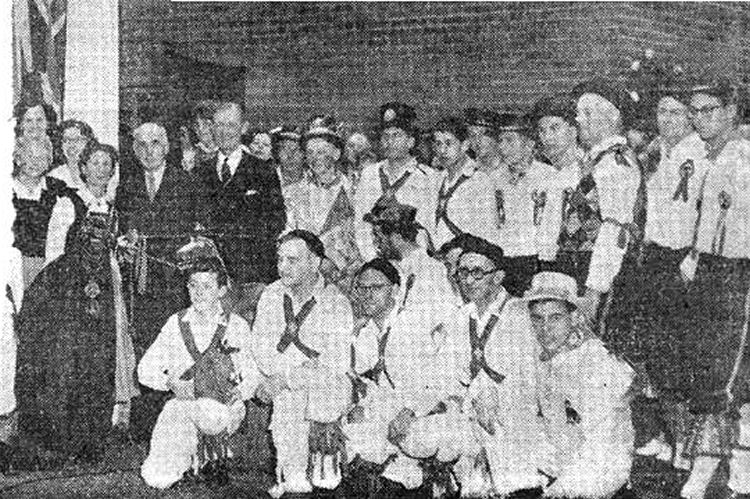
Showing the renaming of the Hooden Horse at Wickhambreaux on 21st July 1956.
Left to right:- Mr. A. Gosby, Lady Mary Findlay, the Mayor and
Mayores of Sandwich, the Mayoress and Mayor of Hythe, lady handbell
ringers, John Field and the Hooden Horse, Sir Stephen Tallents and Cmdr.
N. C. M. Findlay, with the Ravensbourne Morris Men standing, with black
hats and trousers, and kneeling, the East Kent Morris Men.
|
|
From "The Westminster Review ” (Journal of the Westminster Chamber of
Commerce), December 1956.
A PIP INTO HISTORY.
Sir Stephen Tallents, K.C.M.G.
I HAVE taken part in two ceremonies in recent months — both in Kent,
both novel and each likely to remain a unique experience for me. One was
the unveiling of a sign outside a village inn, the other a lecture in
aid of a windmill.
The inn at Wickhambreaux near Canterbury had hitherto borne the name and
sign, not uncommon among hostelries of the "Swan." But its fastidious
owners evidently felt that it merited a more distinctive and
distinguished title. They decided, therefore, to promote it from the
sponsorship of a bird to the patronage of a god. Steeped, much to their
credit, in the local history of its surroundings, they were aware that
the neighbourhood had been successfully invaded in the year 449 a.d. by
Hengist and Horsa. Those conquerors attributed their success to the
support of the god Odin, alias Wooden, and his eight-footed steed,
Sleipner; and their followers thereafter, once a year at the winter
solstice, killed and ceremoniously devoured their favourite horses. In
later centuries this unappetising feast came to be recalled by the
inclusion in carol parties on Christmas Eve of a man wearing the effigy
of a horse's head, with hinged jaws and the bottoms of black bottles for
eyes. So the sign which I unveiled that evening to a chorus of handbell
ringers from Folkestone and a lively performance by Morris Dancers from
Ravensbourne, bore the portrait and the name of the "Hooden Horse."
The proceedings, let me add, were applauded by an enthusiastic clacking
of their wooden jaws by more than one hooden horseman in the capering
company. I wished the inn then, I renew my wishes here, good custom
under its new colours.
|
|
From the
http://hoodening.org.uk/hooden-horses.html accessed 7 July 2019.

The namesake of the Hooden Horse pub in Wickhambreaux (now a private
house) was bought in around 1977, having been made for 'a teacher of
folk dancing in Dover' (Barnett Field?). It is not old. I believe the
photo above shows this horse, which is now used in Ravensbourne. The pub
itself apparently used to have a modern wooden horse's head (only),
mounted next to the bar; it is now in another village pub. |
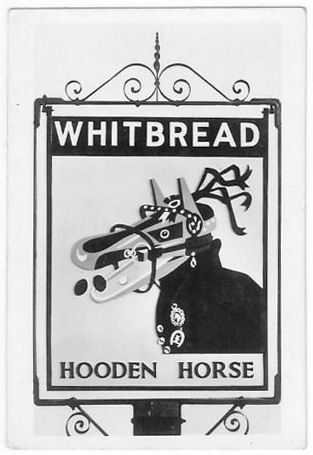 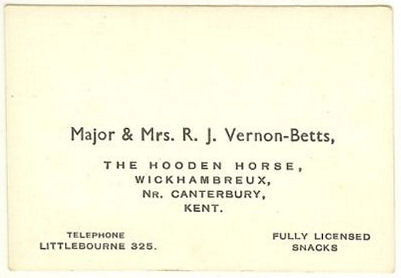
Pictures above show the front and back of a black and white photo
business card from the public house. This recently was placed on Ebay
and eventually sold for £174. (30 November 2009). |
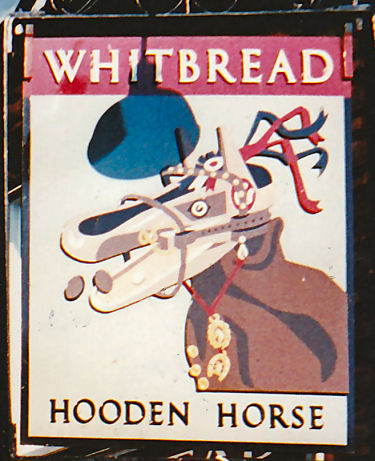
Hooden Horse sign date unknown.
Above with thanks from Brian Curtis
www.innsignsociety.com |
Originally known as the "Swan,"
this pub changed to the "Hooden Horse" on 21st July 1956 and continued under
that name until it's closure some time in 1979.
Application was requested for the land of the pub to be developed and the
change of use from a public house to residential was granted on 20th June,
1979.
And so another one bites the dust.
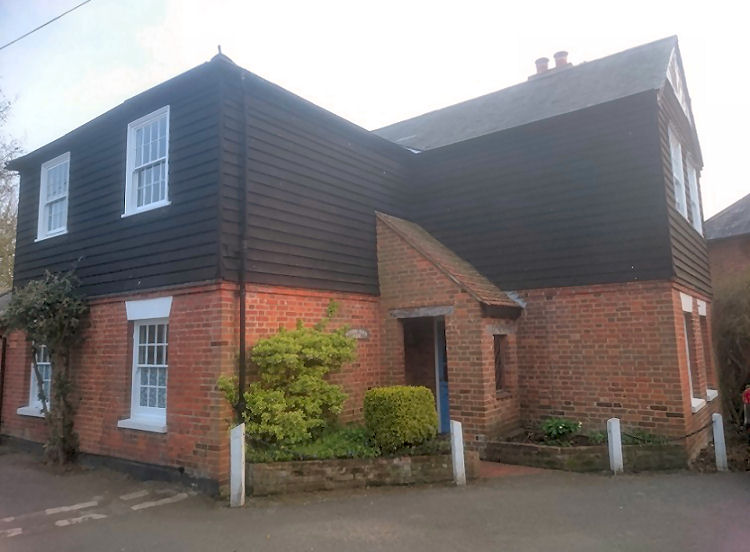
Above photo April 2019, kindly taken and sent by Rory Kehoe. |
|
From a local paper July 1956
Unique Name For Kent Pub The "Hooden Horse"
PAGAN CUSTOM PERPETUATED
After 1,500 years in Kent, the pagan custom of the Hooden Horse has
found a new and permanent home at Wickhambreaux, a few miles from
Canterbury, the cradle of Christianity which overcame the form of
worship it symbolised.
On Saturday this unspoiled village was thronged with people, and some had
come many miles to see the old style of country dancing and
entertainment by the Ravensbourne and East Kent Morris Men with their
squires, fools and hooden horses performed by the quiet green. All were
amused by the antics of the East Kent hooden horse, which went round
collecting for charity, led by 8-year-old John Field, of Hythe.
They followed the dancers along the narrow street, to the Swan Inn of
Messrs. Whitbread to watch the ceremony of renaming it the "Hooden
Horse" - the only one in Britain.
There to see Sir Stephen Tallents, one of
Kent's foremost authorities on
folk-law, unveil this unique inn sign, were the Mayor and Mayoress of
Sandwich (Ald. and Mrs. J. J. Thomas), the Mayor and Mayoress of Hythe
(Cr. and Mrs. C. T. Sandford), Cmdr. N. C. M. Findlay, managing director
of Mackeson's brewery, and Lady Mary Findlay. Mr. J. Marchant, chairman of
the Kent Brewers' Union, and Mrs. Marchant, Miss Anne Roper, the
historian who has written the most informative pamphlet on the origin of
the custom and Mr. A. Gosby, the artist and Mrs. Gosby.
After handbell ringing of old English airs outside the inn by the women
of the Folkestone National Folk Dance Group, Cmdr. Findlay said that The
Swan was in no danger of extinction and that was one of the reasons why
it had been decided that the name should be changed. They had for many
years made their signs vehicles for expressing local traditions of the
village in which the inn was situated.
Mr. John Marchant had been to many libraries,
museums and Government
institutions where old customs were to be found, but inspiration had
come from the Morris Men they had seen on the green. So in the
geographical centre of the country in which the ancient custom was
perpetuated they were making certain it was not entirely forgotten.
NEW EXPERIENCE
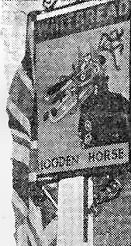 Sir Stephen said he readily accepted to unveil the sign because he liked
collecting new experiences and did not particularly like swans. The word
horse also brought an unpleasant thought to mind - the careering of the
length of Wellington barracks during a parade hanging on to an animal -
but he wished this one long life, and prosperity to the tenants and
customers. Sir Stephen said he readily accepted to unveil the sign because he liked
collecting new experiences and did not particularly like swans. The word
horse also brought an unpleasant thought to mind - the careering of the
length of Wellington barracks during a parade hanging on to an animal -
but he wished this one long life, and prosperity to the tenants and
customers.
Later villagers enjoyed an evening of country dancing in the school
playground.
|
|
From "The Westminster Review" journal of the Westminster Chamber of
Commerce) December 1956.
A DIP INTO HISTORY by Sir Stephen Tallents, K.C.M.G.
I have taken part in two ceremonies in recent months - both in Kent,
both novel and each likely to remain a unique experience for me. One was
the unveiling of a sign outside a village inn, the other a lecture in
aid of a windmill.
The inn at Wickhambreaux near Canterbury had hitherto borne the name and
sign, not uncommon among hostelries, of The Swan. But its fastidious
owners evidently felt that it merited a more distinctive and
distinguished title. They decided, therefore, to promote it from the
sponsorship of a bird to the patronage of a god. Steeped, much to their
credit, in the local history of its surroundings, they were aware that
the neighbourhood had been successfully invaded in the year 449 A.D. by
Hengist and Horsa. Those conquerors attributed their success to the
support of the god Odin, alias Wooden, and his eight-footed steed,
Sleipner; and their followers thereafter, once a year at the winter
solstice, killed and ceremoniously devoured their favourite horses. In
later centuries this unappetising feast came to be recalled by the
inclusion in carol parties on Christmas Eve of a man wearing the effigy
of a horse's head, with hinged jaws and the bottoms of black bottles for
eyes. So the sign which I unveiled that evening to a chorus of handbells
ringers from Folkestone and a lively performance by Morris Dancers from
Ravensbourne, bore the portrait and the name of The Hooden horse. The
proceedings, let me add, were applauded by an enthusiastic clacking of
their wooden jaws by more than one hooden horseman in the capering
company. I wished the inn then, I renew my wishes here, good custom
under its new colours.
|
|
The Hooden Horse of East Kent
by ANNE ROPER, M.B.E., J.P., F.S.A.
The HOODEN HORSE is one of the oldest, the most interesting and most
remarkable survivals of the pagan past in Kent. Although its origin
seems lost in antiquity, the custom is one associated with our
Scandinavian ancestors and their worship of Odin - the Saxon form is "Woden"
- the chief god of northern mythology.
Woden was the ruler of heaven and earth, and in far-off winters, rode
fast through the night sky over the cold plains of Northern Europe, on
his famous horse, Sleipner, which was eight-footed.
At the annual festival of Jul, which celebrated the returning light and
warmth of the sun, at the winter solstice, the old Teutonic tribes
sacrificed their horses as offerings to Odin, and round their fires they
consumed the animals' flesh.
After the Roman occupation of Britain, hordes of Jutes under Hengist and
Horsa invaded the shores of Thanet in 449 A.D. and overran that corner
of Kent. Hey were worshippers of Woden and the traditions of the pagan
customs survive to the present day. To them we owe the Kentish name
Woodnesborough, and our midweek day, Wednesday.
In successive centuries, with the gradual spread of Christianity,
animal sacrifices and the eating of horse flesh were condemned,
specifically by Archbishop Theodore, but it is to these pagan practices
that we trace the Hooden Horse that has persisted even until today, in
the place where in England it probably began, this corner of East Kent.
On Christmas Eve, it was the custom, in almost every village and hamlet
in the Isle of Thanet, and a great deal of the district around, to go
"a-hoodening". The party consisted usually of farm hands, those who were
engaged with horses, Waggoner's and their mates, and originally the
farmer would send his best horse, but as time went on, a full-sized
horse's head, fashioned of wood, was substituted. The Hoodeners were
fantastically dressed, and among them was often one dressed in female
clothes, who carried a birch broom, and was called "The Old Woman" or
just "Mollie". Details of the horse's head differed in various
neighbourhoods. Occasionally large holes were hollowed out for eyes, and
black glass bottoms of bottles were inserted. In Thanet, great hobnails
were driven into the jaws to form teeth, the lower jaw was hung on
hinges, and made to open and shut by means of a string, and it could be
made to snap quite ferociously. The head was fixed to a pole about four
feet in length, and carried by the stoutest "hand", who was called the
Horse. He walked with a stooping gait to make as good a "back" as
possible and was covered with a large horse cloth or sacking. Reins,
ribbons and a bridle were attached to the head and at times one of the
smallest "hands" mounted the Horse to ride like a jockey. The men
carried sheep-bells or handbells, and perhaps one was able to play the
fiddle.
The assembled party set out and visited the various farms and houses,
making plenty of noise to announce their arrival, accompanied by the
"clap clapping" of the Horse's jaws. As soon as the door was flung open,
the Waggoner cracked his whip, and led in the Horse prancing, snorting,
gnashing his teeth, kicking, and rearing very spirited, while Mollie
began energetically to sweep the feet of the first person to appear.
When the faun and laughter had subsided, the Hoodeners rang their
handbells, and sang some carols, and were regales with home brewed ale,
cider and cakes, or on more fortunate occasions with contributions of
money.
But countrymen in their enthusiasm do not always deal kindly with
ancient customs. "Hob Nob" at Salisbury had to be locked in the City
Museum. At Broadstairs, after a woman was alleged to have been
frightened to death in meeting a party of Hoodeners, the Magistrate
suppressed the custom in that town, but it continued further down the
coast as far as Deal, and as far inland as Canterbury. One Hooden Horse
at Lower Hardres in 1859 caused a crippled woman to jump from her chair
and run. This Horse was so respected by her German husband that he
bought it and took it with him to Germany.
With te coming of the petrol engine, there are fewer horses, fewer
Waggoner's; stables, alas, have become tractor sheds, and the old Hooden
Horse has been taken down from the walls and burned in the stackyard.
Yet the tradition remained, and the Hooden Horse, modelled on the one
formerly at Deal, re-appeared at Folkestone at the Coronation festivals
of Queen Elizabeth II, resurrected appropriately by the Folkestone
National Folk Dance Group. Each successive Christmas, while cold winds
streak across Kent from Scandinavia, the party may be seen, with their
handbells, and the gallant Horse prancing as grotesquely as ever, making
the rounds to give pleasure and to collect and swallow money, now, for
some thoroughly deserving cause.
At Whitsuntide, the Hoodeners set out from Charing, with the Horse and
the East Kent Morris Men, bringing tidings of Spring fertility to the
countryside and coast.
In this modern mechanical age, there is still room for these curious old
customs, and how immeasurably poorer we should be without them. They are
not simply cherished fancies of the "good old days", for future
generations. The Hooden Horse is now depicted on the sign of an inn at
Wickhambreaux, and as long as it hangs there, in the heart of the Hooden
Horse country, this popular Kentish custom, though pagan in origin, will
be perpetuated in the minds and memory of all who pass that way.
ANNE ROPER.
|
LICENSEE LIST
VERNON-BETTS Major R J after 1956+
BECKETT C 1961+
http://www.closedpubs.co.uk/hoodenhorse.html
|







 Sir Stephen said he readily accepted to unveil the sign because he liked
collecting new experiences and did not particularly like swans. The word
horse also brought an unpleasant thought to mind - the careering of the
length of Wellington barracks during a parade hanging on to an animal -
but he wished this one long life, and prosperity to the tenants and
customers.
Sir Stephen said he readily accepted to unveil the sign because he liked
collecting new experiences and did not particularly like swans. The word
horse also brought an unpleasant thought to mind - the careering of the
length of Wellington barracks during a parade hanging on to an animal -
but he wished this one long life, and prosperity to the tenants and
customers.